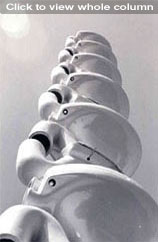
| The
column of toilets is an homage to two of the most influential artists
of the 20th century - Constantin Brancusi and Marcel Duchamp. The
sculpture was born as a parody on Duchamp's Fauntain (1917) and, moreover,
can be seen as an ironic reaction to Brancusi's Endless Column. In
this project, as well, through repetition, the modular units accumulate
to form a column which serves as a mediator between earth and sky.
The Endless Column expressed Broncusi's spiritual desire. Therefore,
the basic element was designed to be a geometrical form, as clean
as possible, without any unnecessary connections. In contrast, the
basic unit of the toilet column makes reference, in a very harsh manner,
to the bodily context. Yet, even this column might absorb and in turn, project spiritual energy. In spite of its simplicity, the sculpture deals with the duality of spirit and matter, divinity and profanity, purity and filth, art and life. At first sight, from a distance, the column transmits a sense of clarity and wholeness; but when the gaze becomes a tool of discovery, the viewer is troubled by the fact that what he sees is, in fact, an everyday product with unpleasent associations. The sculpture is thus nourished by the tension between the external appearance of a brilliant rising form in elegant and tythmic motion and the hint of the hidden existence of the flush. |
| -- Avraham Eilat, Oct. 1997 |
 |
|
 |
The sound track was created by musician Yossi MarHaim. He remarks:
The sound is based on recordings of Eilat's speech therapy exercises.
The intonation is imitated with a synthesizer. Each 5-minute musical cycle ends with rising electronic tones inspired by the rhythmic elevation of the column. The selection of materials follows Duchamp's lottery-like process of choosing notes for creating music. Since the entire work is done with a computer, typical commands such as return, paste, close, shift, etc., were employed.


